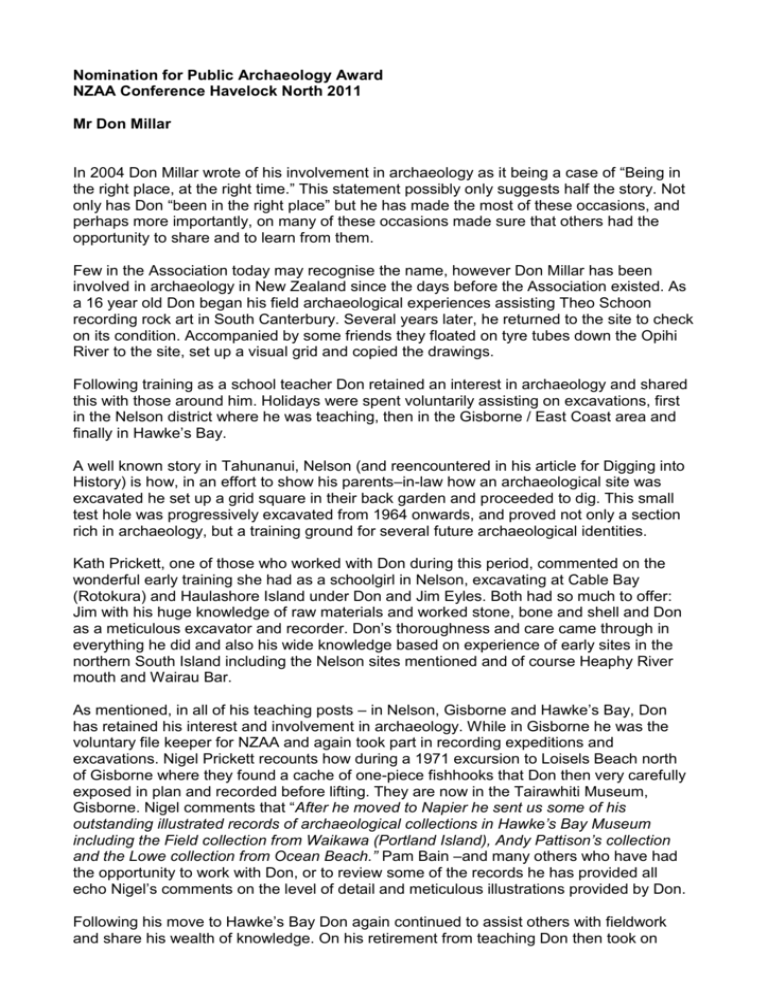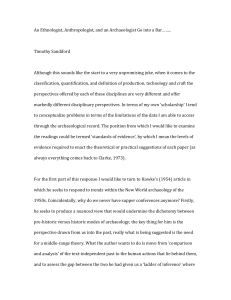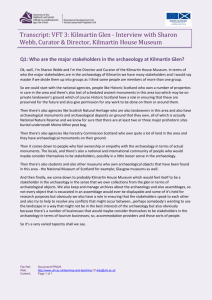Nomination for Publi.. - New Zealand Archaeological Association
advertisement

Nomination for Public Archaeology Award NZAA Conference Havelock North 2011 Mr Don Millar In 2004 Don Millar wrote of his involvement in archaeology as it being a case of “Being in the right place, at the right time.” This statement possibly only suggests half the story. Not only has Don “been in the right place” but he has made the most of these occasions, and perhaps more importantly, on many of these occasions made sure that others had the opportunity to share and to learn from them. Few in the Association today may recognise the name, however Don Millar has been involved in archaeology in New Zealand since the days before the Association existed. As a 16 year old Don began his field archaeological experiences assisting Theo Schoon recording rock art in South Canterbury. Several years later, he returned to the site to check on its condition. Accompanied by some friends they floated on tyre tubes down the Opihi River to the site, set up a visual grid and copied the drawings. Following training as a school teacher Don retained an interest in archaeology and shared this with those around him. Holidays were spent voluntarily assisting on excavations, first in the Nelson district where he was teaching, then in the Gisborne / East Coast area and finally in Hawke’s Bay. A well known story in Tahunanui, Nelson (and reencountered in his article for Digging into History) is how, in an effort to show his parents–in-law how an archaeological site was excavated he set up a grid square in their back garden and proceeded to dig. This small test hole was progressively excavated from 1964 onwards, and proved not only a section rich in archaeology, but a training ground for several future archaeological identities. Kath Prickett, one of those who worked with Don during this period, commented on the wonderful early training she had as a schoolgirl in Nelson, excavating at Cable Bay (Rotokura) and Haulashore Island under Don and Jim Eyles. Both had so much to offer: Jim with his huge knowledge of raw materials and worked stone, bone and shell and Don as a meticulous excavator and recorder. Don’s thoroughness and care came through in everything he did and also his wide knowledge based on experience of early sites in the northern South Island including the Nelson sites mentioned and of course Heaphy River mouth and Wairau Bar. As mentioned, in all of his teaching posts – in Nelson, Gisborne and Hawke’s Bay, Don has retained his interest and involvement in archaeology. While in Gisborne he was the voluntary file keeper for NZAA and again took part in recording expeditions and excavations. Nigel Prickett recounts how during a 1971 excursion to Loisels Beach north of Gisborne where they found a cache of one-piece fishhooks that Don then very carefully exposed in plan and recorded before lifting. They are now in the Tairawhiti Museum, Gisborne. Nigel comments that “After he moved to Napier he sent us some of his outstanding illustrated records of archaeological collections in Hawke’s Bay Museum including the Field collection from Waikawa (Portland Island), Andy Pattison’s collection and the Lowe collection from Ocean Beach.” Pam Bain –and many others who have had the opportunity to work with Don, or to review some of the records he has provided all echo Nigel’s comments on the level of detail and meticulous illustrations provided by Don. Following his move to Hawke’s Bay Don again continued to assist others with fieldwork and share his wealth of knowledge. On his retirement from teaching Don then took on another role. Between 1990 and 2009 Don acted as the voluntary curator of Maori Taonga at the Hawke’s Bay Museum and Art Gallery. As part of role he shared with visitors – (public and school groups) the value and knowledge of the collection. Don committed several days a week for almost 20 years to attending the museum to catalogue material in the collection, again adding incredible detail to drawings and information. Over this period Don also authored a book with friend Des Harris, on historic pharmacies in Napier – Napier’s Medicine Makers, providing information not only on the businesses in the town from the 1860s, but again, meticulous drawing. This book is now a key reference for historic archaeology in the district. Over many years and in a variety of voluntary roles, Don Millar has enhanced the archaeological record in New Zealand – providing detailed and meticulously drawn records, cataloguing a number of significant collections for museums and most significantly sharing his deep knowledge and enthusiasm with many hundreds others. Through his role at the museum Don built strong relationships with local iwi, gaining respect and understanding for the work he was carrying out caring for taonga held by the museum, at the same time sharing knowledge on the importance of recording and preserving information on both sites and material culture. Based on the above, which only scratches the surface of work that Don Millar has carried out over the years, that we feel he is worthy of recognition in the award for Public Archaeology. Cathryn Barr (with information and support for the nomination from Pam Bain, Elizabeth Pishief, Ian Barber, Nigel and Kath Prickett).





